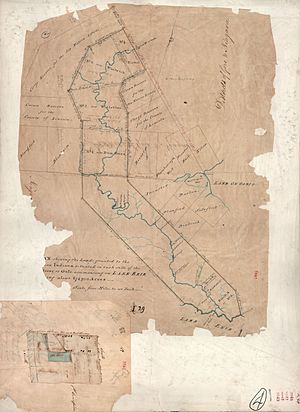Haldimand Proclamation facts for kids
The Haldimand Proclamation was a decree that granted land to the Mohawk (or Kanien'kehà:ka) (Mohawk nation) who had served on the British side during the American Revolution. The decree was issued by the Governor of the Province of Quebec, Frederick Haldimand, on October 25, 1784, three days after the Treaty of Fort Stanwix was signed between others of the Six Nations and the American government. The granted land had to be purchased from the Mississaugas of the Credit whose traditional territory spans much of modern day Southwestern Ontario. On May 22, 1784 Col. John Butler was sent to negotiate the sale of approximately 3,000,000 acres of land located between Lakes Huron, Ontario, and Erie for £1180.00 from the Mississaugas of the Credit. Of the land ceded, some 550,000 acres were granted to the Mohawk nation in the Haldimand Proclamation. The sale by the Mississaugas of the Credit is also referred to as the "Between the Lakes Treaty."
Proclamation text
The text of the proclamation reads:
Whereas His Majesty having been pleased to direct that in consideration of the early attachment to his cause manifested by the Mohawk Indians, and of the loss of their settlement which they thereby sustained-- that a convenient tract of land under his protection should be chosen as a safe and comfortable retreat for them and others of the Five Nations, who have either lost their settlements within the Territory of the American States, or wish to retire from them to the British -- I have at the earnest desire of many of these His Majesty's faithful Allies purchased a tract of land from the Indians situated between the Lakes Ontario, Erie and Huron and I do hereby in His Majesty's name authorize and permit the said Mohawk Nation and such others of the Five Nation Indians as wish to settle in that quarter to take possession of and settle upon the Banks of the River commonly called Ours [Ouse] or Grand River, running into Lake Erie, allotting to them for that purpose six miles deep from each side of the river beginning at Lake Erie and extending in that proportion to the head of the said river, which them and their posterity are to enjoy for ever."
Given under my hand and seal at arms, at the Castle of St Lewis at Quebec, this twenty-fifth day of October one thousand seven hundred and eighty-four and in the twenty-fifth year of the reign of Our Sovereign Lord George The Third by the Grace of God of Great Britain, France and Ireland, King, Defender of the Faith and so forth.
Fredk Haldimand
By His Excellency's Command
R. Mathews
Background
Mohawk Joseph Brant and Guy Johnson, who had been ejected from his post as Superintendent of Indian Affairs a few months before, traveled to London, England in November 1775, on the eve of the American Revolution, to obtain a promise from the Crown that if the Iroquois fought on the British side, they would obtain a land grant in Canada. During and after the American Revolution, American colonists confiscated land and property from those who were Loyalists during the war. The British government compensated both Indian and non-Indian Loyalists with cash payments for their losses.
By early 1783, Brant had selected the valley of the Grand River as a place of settlement; in 1784 Frederick Haldimand agreed. The land was acquired from the Mississaugas in May 1784, with Lieutenant-Colonel John Butler acting as an agent of purchase on behalf of the government.
Later, the Crown adopted the position that it had failed to obtain title to the entire valley at the time of its purchase from the Mississaugas.
Moratorium on development
In April 2021, nine months into the land reclamation action by the people at 1492 Land Back Lane, the Haudenosaunee Confederacy Chiefs Council announced a moratorium on development within the entire Haldimand Tract. This call was acknowledged and supported by the Six Nations Elected Council, in an effort to present a unified front while land claims disputes were sorted out with the federal government.


